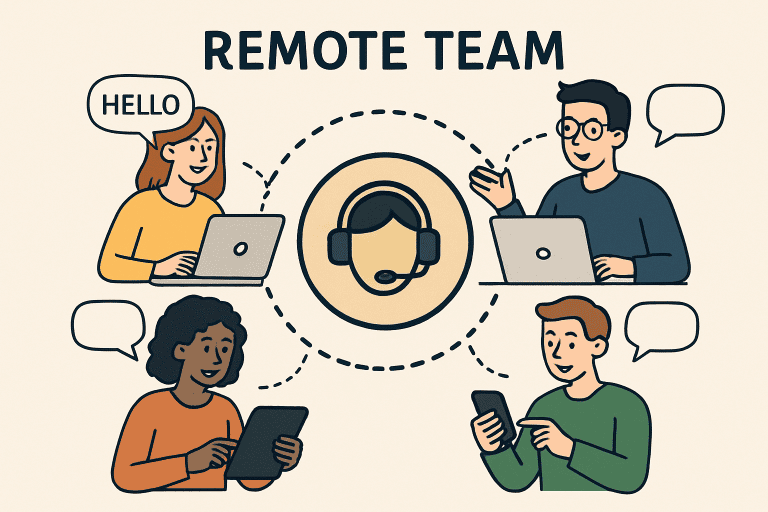
Key Takeaways
Virtual assistants free up core staff to focus on primary business functions, increasing productivity.
They provide access to specialized skills on demand, helping businesses scale without long-term commitments.
VAs improve remote team communication and coordination, especially across time zones.
Emerging technologies like AI and machine learning are further enhancing the role and impact of VAs.
Table of Contents
Introduction
Enhancing Productivity Through Task Delegation
Access to Specialized Skills Without Full-Time Commitments
Facilitating Seamless Communication and Collaboration
Leveraging Technological Advancements
Cost-Effective Solutions for Businesses
Improving Work-Life Balance for Remote Workers
Adapting to the Future of Work
Introduction
As remote work reshapes industries worldwide, businesses turn to innovative solutions to remain agile, efficient, and competitive. Among these solutions, the rise of virtual assistants (VAs) is a pivotal factor changing the nature of modern workplaces. These professionals—and the VA agency networks that connect them to large and small companies—are redefining how teams operate, manage their time, coordinate workflow, and execute collaborative projects in a dispersed work environment. The involvement of skilled VAs has opened up operational efficiencies that were once unattainable, offering businesses the unique ability to streamline processes critical to their success in a digital-first era.
Virtual assistants play an instrumental role in contemporary business models by taking ownership of repetitive tasks and essential administrative duties, which can otherwise consume the valuable time of highly skilled staff. By delegating such work, companies empower their in-house teams to concentrate on their core competencies and primary objectives, supporting focus on strategy, innovation, and client engagement. Moreover, the remote nature of VAs aligns seamlessly with digital business structures, allowing organizations to scale operations instantly, realize significant cost savings, and benefit from increased agility. By accessing global talent pools without the constraints of geography or traditional hiring, businesses gain flexibility that puts them at a distinct competitive advantage.
Enhancing Productivity Through Task Delegation
Virtual assistants expertly handle essential yet repetitive workflows—such as email triage, calendar scheduling and management, travel arrangements, data entry, and routine reporting—that would otherwise drain the productivity of highly skilled employees. By entrusting VAs with these recurring tasks, remote workers and business leaders can redirect their attention toward high-impact projects and innovative initiatives that drive business growth. Numerous studies, including the Harvard Business Review findings, demonstrate that minimizing multitasking and eliminating non-core distractions allows teams to achieve higher engagement, improved creative output, and better overall results. Organizations that leverage the support of VAs often experience a boost in project delivery speed, fewer errors in routine processes, and more time for strategic thinking—all factors that contribute directly to a team’s productivity and morale. In this way, delegating routine responsibilities to VAs becomes both a tactical and strategic move for any organization navigating the demands of a remote workforce.
Access to Specialized Skills Without Full-Time Commitments
One of the most potent benefits of hiring virtual assistants is the ability to tap into a vast and diverse range of specialized skills on demand. The global nature of remote work means businesses are no longer limited by geographic proximity when seeking expertise. Whether a company needs digital marketing support, bookkeeping, project management, technical troubleshooting, advanced research, or bilingual customer service, a VA specializes in virtually every business function. This flexible arrangement is especially valuable for startups, small businesses, and rapidly scaling organizations facing fluctuating workloads and priorities. Because VAs can be engaged for short-term projects, part-time assignments, or ad hoc support, companies can efficiently fill expertise gaps as they arise—without incurring the expense or rigidity associated with traditional full-time hiring. By utilizing this just-in-time talent model, organizations achieve a workforce dynamism that would have been almost impossible in legacy office settings.
Facilitating Seamless Communication and Collaboration
Effective communication and collaboration are cornerstones of successful remote teams, and virtual assistants are often the glue that holds these dispersed environments together. VAs usually manage digital collaboration tools—such as Slack, Microsoft Teams, Asana, Trello, Zoom, and Google Workspace—ensuring that information flows seamlessly throughout an organization. They are responsible for keeping team calendars up to date, organizing and documenting meetings, tracking deliverables, and updating shared project dashboards, which maintains alignment across departments, partners, and even time zones. A VA’s attention to organizational detail is vital to ensuring the timely delivery of projects and maintaining accountability in distributed teams. As more workforces span continents and time zones, VAs who can coordinate collaborations across different cultural and functional boundaries have become indispensable. According to Forbes, companies that leverage VAs for coordination and communication report fewer project delays and improved organizational coherence, allowing teams to stay connected and focused on shared objectives at every project execution stage.
Leveraging Technological Advancements
The evolving landscape of virtual assistance is deeply intertwined with technological advancement. Artificial intelligence (AI) and machine learning (ML) now play a critical role in many VA platforms and tools, enabling more sophisticated approaches to data analysis, automated scheduling, and predictive customer support. Intuitive chatbots, intelligent document management systems, automated workflow tools, and AI-driven analytics have transformed the scope of what VAs can deliver. With these technologies, previously manual or time-consuming processes—like customer query routing, appointment scheduling, database management, and real-time reporting—can now be handled with incredible speed and accuracy. As VAs access more robust software and platforms, businesses can automate complex processes, derive actionable insights from their operational data, and respond proactively to market changes. This ongoing integration of technology strengthens the impact of VAs, giving companies new ways to differentiate themselves and remain competitive in an increasingly digital landscape.
Cost-Effective Solutions for Businesses
One of the most compelling reasons organizations of all sizes embrace virtual assistants is the significant cost savings they bring. Since VAs work remotely, businesses can avoid expenses related to physical office space, equipment, paid leave, and benefits associated with in-house employees. Instead, companies can engage VAs on a flexible, as-needed basis, paying only for the required services or hours. This model of outsourcing allows organizations to ramp support up or down as business cycles shift, efficiently allocating resources where they are needed most without long-term commitments. By reducing fixed costs and investing instead in agile, scalable support through VAs, businesses can increase their budgets for innovation, growth initiatives, or competing priorities. The result is a leaner, more adaptable business that remains financially resilient and growth-oriented, even as market conditions fluctuate.
Improving Work-Life Balance for Remote Workers
With virtual assistants managing time-consuming or complex administrative responsibilities, remote employees enjoy a more balanced and stress-free work experience. By offloading routine tasks to VAs, teams boost their productivity and free up hours each week for skill development, personal time, or creative thinking. This reduction in day-to-day friction supports higher job satisfaction, better mental health outcomes, lower staff turnover, and increased employee motivation. Balanced teams are more resilient and prove more effective in the long term, helping businesses sustain productivity and performance over months and years rather than just weeks. For many companies, investing in VA support has become a key pillar of building a supportive and sustainable remote work culture where employees can thrive personally and professionally, ultimately leading to superior business results and stronger retention rates.

Adapting to the Future of Work
The global shift towards remote work is far from a passing trend—it represents a structural change in how organizations will operate for years. As companies and employees increasingly embrace telecommuting and hybrid options, the role of virtual assistants will continue to expand and evolve. Businesses incorporating VAs into their daily operations position themselves well to outpace competitors, swiftly adapt to changing market landscapes, and consistently deliver exceptional customer experiences. From agile startups disrupting traditional markets to established enterprises reinventing legacy processes, VAs are a cornerstone of the future of productive, flexible, and resilient remote teams willing to innovate. The integration of VA support allows organizations to remain nimble, tackle new challenges, and capture opportunities as the world of work is redefined.
Virtual assistants have rapidly evolved from convenient administrative helpers to essential drivers of business transformation in the remote era. By leveraging their expertise, embracing new technologies, and tapping into their diverse skills, companies unlock higher productivity, ensure greater agility, and support a happier, more efficient workforce. Embracing VA support is not just a smart operational move—it’s a forward-thinking strategy that prepares organizations for sustainable growth in the rapidly changing future of work.

This post has been published by the admin of our website, responsible for content management, quality checks, and providing valuable information to our users.